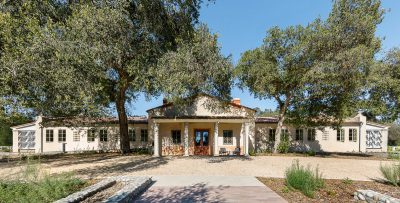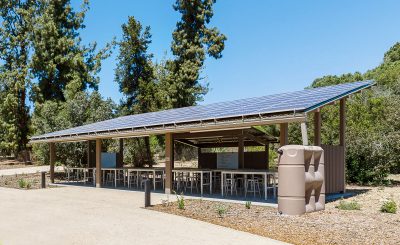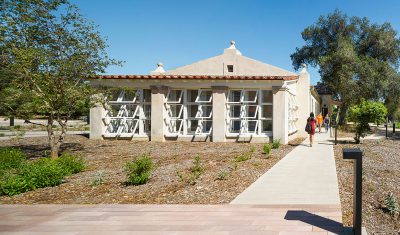 Claremont, Calif. (June 1, 2018)—Pitzer College’s Robert Redford Conservancy for Southern California Sustainability has been awarded LEED Platinum certification by the US Green Building Council (USGBC). LEED, or Leadership in Energy & Environmental Design, is a globally recognized symbol of excellence in green building. The Redford Conservancy joins a slate of green buildings on Pitzer’s campus, where nearly 70 percent of students live in LEED-certified housing.
Claremont, Calif. (June 1, 2018)—Pitzer College’s Robert Redford Conservancy for Southern California Sustainability has been awarded LEED Platinum certification by the US Green Building Council (USGBC). LEED, or Leadership in Energy & Environmental Design, is a globally recognized symbol of excellence in green building. The Redford Conservancy joins a slate of green buildings on Pitzer’s campus, where nearly 70 percent of students live in LEED-certified housing.
The Robert Redford Conservancy, located on 12 acres north of Pitzer’s main campus, held its first full semester of classes and programming this spring following a year-long renovation of the historic Claremont Colleges infirmary. That top-to-bottom renovation turned an abandoned, nearly 90-year-old facility into a showcase for responsible, collaborative green building. In addition to earning USGBC’s highest LEED certification in the New Construction and Major Renovation category, the Redford Conservancy is on track to becoming The Claremont Colleges’ first net zero energy building, meaning it produces as much energy as it uses over the course of the year.
 Solar arrays crown the Redford Conservancy’s two outdoor classrooms and are expected to generate approximately 88,000 kWh per year, enough to meet the Redford Conservancy’s energy needs. Daylighting—reliance on natural versus electric light—illuminates many of the indoor learning spaces.
Solar arrays crown the Redford Conservancy’s two outdoor classrooms and are expected to generate approximately 88,000 kWh per year, enough to meet the Redford Conservancy’s energy needs. Daylighting—reliance on natural versus electric light—illuminates many of the indoor learning spaces.
To reduce carbon emissions during the renovation, the construction team incorporated more than 90 percent of the building’s existing envelope and structural elements. The team re-used most of the building’s original clay roofing tiles and purchased any replacements from the tiles’ original manufacturer.
Landscaping around the building is made up almost entirely of native plants that need minimal irrigation. Many of these plants were cultivated at the neighboring Rancho Santa Ana Botanic Garden from seeds found on site and planted in the fall, during native plants’ growing season. Redford Conservancy Director Brinda Sarathy consulted Tongva Elders as well as biologists to ensure plantings were indigenous to the area and culturally significant for the land’s native people.
 The Redford Conservancy design blurs the lines between the outdoors and indoors. Four of the Conservancy’s nine new teaching spaces are outdoors. In addition to the two outdoor classrooms, council rings encourage face-to-face discussions in the open air. A Science Sun Room and an Art Sun Room draw in the outdoors by taking advantage of daylight to minimize reliance on electricity.
The Redford Conservancy design blurs the lines between the outdoors and indoors. Four of the Conservancy’s nine new teaching spaces are outdoors. In addition to the two outdoor classrooms, council rings encourage face-to-face discussions in the open air. A Science Sun Room and an Art Sun Room draw in the outdoors by taking advantage of daylight to minimize reliance on electricity.
Nearly 90 percent of the total site is undeveloped open space. Sarathy, an associate professor of environmental analysis at Pitzer who oversaw the renovation plans, emphasizes that the Redford Conservancy is more than a building—it is a slice of Southern California, an alluvial fan formed at the base of the San Gabriel Mountains and covered by endangered coastal sage scrub habitat. And just as important as its natural history is its cultural history as the Tongva people’s ancestral land.
A group of architects, engineers, builders and advisers worked together to achieve LEED Platinum certification. That team includes: Carrier Johnson, Studio-MLA, Integral Group, KAR, Pitzer College Facilities and the Redford Conservancy Planning Committee.
“Together the team contributed to the design and renovation of this facility, so it now embodies beauty, sustainability and a spirit of true collaboration,” Sarathy said.
The USGBC’s LEED rating system promotes cost-efficient and energy-saving green buildings with lower carbon emissions. LEED certification is based on the total number of points a project earns in various compliance categories, such as Energy & Atmosphere, Sustainable Sites and Indoor Environmental Quality. The Redford Conservancy was awarded LEED points for everything from its energy-producing solar panels to its drought-tolerant landscaping. Its sustainable features include:
- Two 26.2 KVA Photovoltaic Arrays, one on each outdoor classroom, which are expected to generate 88,000 kWh/year—enough to offset all of the building’s anticipated energy use
- More than 90 percent of the building’s existing envelope and structural elements (including exterior walls, foundation, interior structural walls and roof deck) were reused to minimize carbon emissions
- Recycled content, FSC-certified wood and locally sourced materials
- Native and endemic plants that reduce potable water use by 64 percent
- Open space—nearly 90 percent of the total site is undeveloped
- Stormwater management reduces the amount of runoff from the site
- Reflective roof material minimizes the heat-island effect
- Minimal parking and proximity to The Claremont Colleges to services encourages visitors and students to commute by foot instead of by car
- Efficient plumbing fixtures reduce indoor water use by 35 percent
- Mechanical design incorporates natural ventilation and exceeds ventilation requirements by 30 percent
- Low-emitting adhesives, sealants, paints, coatings, flooring systems and composites used throughout
- Lighting and thermal comfort controls
- Daylighting in more than 75 percent of regularly occupied areas
The Redford Conservancy’s LEED Platinum rating continues Pitzer College’s quest to live its core value of environmental sustainability. In 2012, Phase II of Pitzer’s Master Housing Plan, which now includes East, West and Skandera Halls, also earned LEED Platinum certification. Four years earlier, Pitzer Hall, Atherton Hall and Sanborn Hall earned LEED Gold certification—the highest rating available at the time. Off campus, the College’s President’s Residence became the first private home in Claremont to earn LEED certification following a renovation in 2014.
Established in 2012, The Robert Redford Conservancy for Southern California Sustainability at Pitzer College is a leader in innovative academic programming and interdisciplinary education around environmental challenges. Academically driven by the liberal arts and guided by Pitzer College’s core values of social responsibility and environmental sustainability, the Redford Conservancy engages interdisciplinary and collaborative approaches to environmental problem solving. The Redford Conservancy expands on the College’s legacy promoting socio-environmental awareness for both the longevity of Southern California’s natural environment and the wellbeing of its peoples.